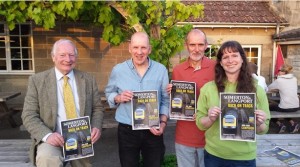By Daniel Mumby for the Western Gazette

Photograph in the Western Gazette showing members of the transport task force of Transition Langport who are behind the concept of the Somerset District and Circle Line
An environmental group in Langport has said that a new railway station would create a “sea change” of improvements to the town.
Transition Langport is calling for a feasibility study into a new station on the former Langport East station site at Eastover.
At their recent meeting at The Rose and Crown in Huish Episcopi, Transition Langport endorsed the Western Gazette’s Back On Track campaign for a new station to serve Somerton and Langport.
The original station closed in September 1962 as a result of the Beeching cuts initiated by Harold Macmillan’s Conservative government.
Transition Langport has been campaigning for a new station since 2007, citing it as one of the major concerns of residents in Langport and Huish Episcopi.
Transition member Cara Naden said: “We carried out a survey in December 2011, and we found that the two things people disliked most about the community were the traffic problems on Bow Street and the lack of a railway station.”
Having presented their findings to Langport Town Council, a working group was set up in 2012 to look into transport solutions for the town, including bringing back regular rail services.
For Transition member Phil Edge, bringing a station back to Langport is a no-brainer.
He said: “Langport and Huish Episcopi lie in the centre of a large area of central Somerset which is denied easy access to the rail network. The nearest stations – Taunton, Castle Cary, Bridgwater and Yeovil Junction – are all 12 to 15 miles away. There is no bus to Castle Cary or Taunton stations, so most people drive.
“Since the Beeching cuts, the population of Langport and Huish Episcopi has more than doubled, from 1,722 in 1961 to around 3,500 in 2011, according to official Census figures.
“Bow Street is still the only road through Langport and is too narrow and unsafe for today’s heavy traffic flows on the A378.”
Mr Edge added that most of the population of Langport and Huish Episcopi live within a mile’s walk of the Langport East site.
For those needing to travel by car, a car park could be constructed on a field adjacent to Langport & Huish Cricket Club.
Transition member Martin Read said: “There is a field adjacent to the cricket pitches which is currently owned by the Lloyd Family Trust. That could be used for a car park.
“That field links up with Station Path, which was refurbished in 2013 and runs all way down to Eastover.
Mr Edge added that the existing rail infrastructure at Langport had proved its worth during the floods of 2013-14.
He said: “When we had the floods, there was no rail service between Taunton and Bridgwater, so all the rail traffic from Bridgwater was sent around the long way through Langport. Clearly there’s the capacity.”
Transition Langport has welcomed the recent announcement by Chancellor of the Exchequer George Osborne that the New Stations Fund, set up in 2013, would be renewed.
But Mr Read emphasised that plans for a new station would get nowhere without a feasibility study.
He said: “To get access to the New Stations Fund, we have to do a feasibility study. We have to show the social, economic, environmental and financial benefits of the station, and that could cost anything from £50,000 to £100,000 to put together.
“Getting this study done is absolutely key to getting railway services back. We are calling on the Local Enterprise Partnership to stump up for this, to say: ‘We’ll fund this and see where we go from here.’
Ms Naden added: “There is probably no other single project that could have anything like the same positive impact on quality of life, environment, economic development and the general wellbeing of the community as reopening the station.
“We believe it is the most important and realistically achievable single step we can take in the transition to a healthy, sustainable community.”
Read the full article here.